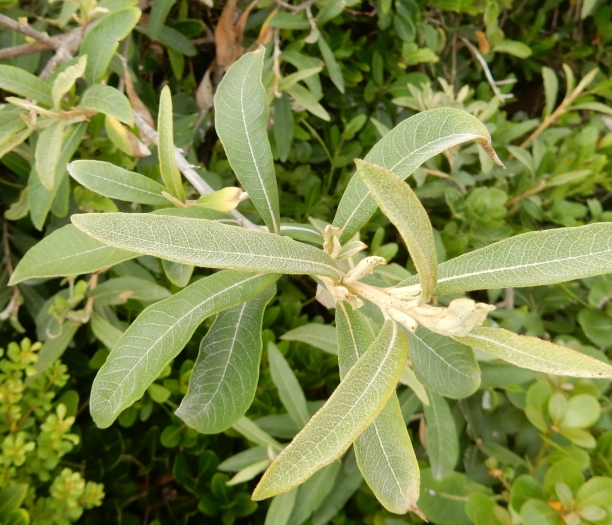Camphor Bush
(Tarchonanthus littoralis)
Camphor Bush (Tarchonanthus littoralis)
/
/

Henry de Lange
CC BY 4.0
Image By:
Henry de Lange
Recorded By:
Copyright:
CC BY 4.0
Copyright Notice:
Photo by: Henry de Lange | License Type: CC BY 4.0 | License URL: http://creativecommons.org/licenses/by/4.0/ | Rights Holder: Henry de Lange | Publisher: iNaturalist | Date Created: 2023-01-27T14:58:05Z |













Estimated Native Range
Summary
Tarchonanthus littoralis, commonly known as Camphor Bush or Coastal Tarchonanthus, is a semi-deciduous shrub native to the coastal regions of Southern Africa, including coastal dunes, rocky outcrops, and along riverbanks. It is well-adapted to its native habitat, thriving in the sandy and well-drained soils found in these areas. The plant exhibits a moderate growth rate and can reach a height of 3.25-26 feet (1-8 meters) with a width of 6.5-16 feet (2-4.9 meters). Its appearance is characterized by a dense, rounded form with gray-green leaves that emit a camphor-like scent when crushed. The cream-colored flowers bloom in the spring and are modest in showiness, but they attract a variety of pollinators.
Camphor Bush is valued for its aromatic foliage and adaptability to coastal conditions, making it suitable for seaside gardens, hedges, and as a windbreak. It is also used for its medicinal properties and as a source of fragrant wood. In cultivation, it requires full sun to part shade and performs best in medium or fast-draining clay, loam, or sandy soils. It is drought-tolerant once established, requiring only medium amounts of water. While generally pest-free, it can be susceptible to root rot if overwatered or planted in poorly drained soils.CC BY-SA 4.0
Camphor Bush is valued for its aromatic foliage and adaptability to coastal conditions, making it suitable for seaside gardens, hedges, and as a windbreak. It is also used for its medicinal properties and as a source of fragrant wood. In cultivation, it requires full sun to part shade and performs best in medium or fast-draining clay, loam, or sandy soils. It is drought-tolerant once established, requiring only medium amounts of water. While generally pest-free, it can be susceptible to root rot if overwatered or planted in poorly drained soils.CC BY-SA 4.0
Plant Description
- Plant Type: Shrub
- Height: 3.25-26 feet
- Width: 6.5-16 feet
- Growth Rate: Moderate
- Flower Color: Cream
- Flowering Season: Spring
- Leaf Retention: Semi-deciduous
Growth Requirements
- Sun: Full Sun, Part Shade
- Water: Medium
- Drainage: Medium, Fast
Common Uses
Bird Garden, Drought Tolerant, Erosion Control, Fragrant, Hedges, Low Maintenance
Natural Habitat
Native to coastal regions of Southern Africa, including coastal dunes, rocky outcrops, and along riverbanks
Other Names
Common Names: Coastal Tarchonanthus
Scientific Names: , Tarchonanthus littoralis,
GBIF Accepted Name: